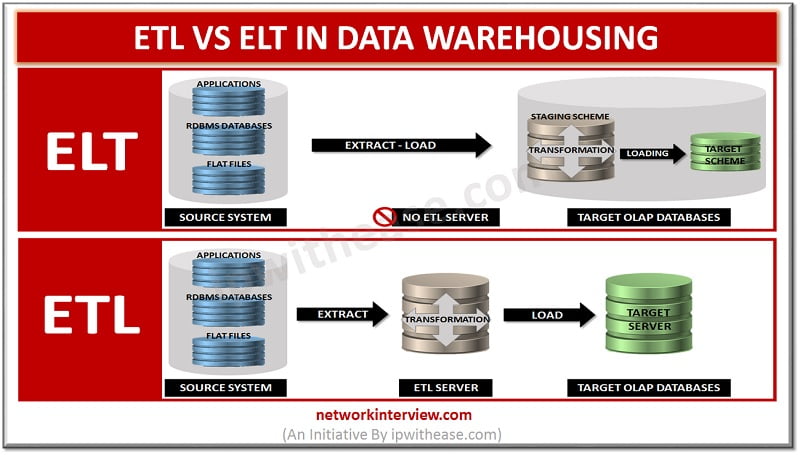
ETL vs ELT in Data Warehousing
ETL vs ELT in Data Warehousing
ETL:
When the data is extracted from disparate sources and then it is transformed, the process is termed as ETL (extract, transform, and load). For data transformation, the actions performed include applying calculations and or altering the data types. After transformation of data is done, its loading takes place in target database that is data warehouse. The heavy lifting bulk, that is, the transforming part is conducted by ETL software when ETL is performed by user. Following are the cases in which ETL is use:
- The target and source database are different and varied forms of data are used by them
- Structured data is present
- Compute intensive transformations are there
- Small or moderate data volumes are there
Advantages:
OLAP data warehouse’s pre-structured nature serves to be the biggest advantage of ETL. After data transforming/structuring, efficient, speedier and stable analysis is allowed by ETL. This is not the case with ELT. Compliance serve as the other advantage of ETL. In case when some other techniques are used by companies for their clients’ privacy protection, there is need to mask, remove or encrypt particular fields of data. These transformations are carried out in safer manner by the method offered by ETL. This is because data is transformed before it is kept in data warehouse.
The compliance violations risk is reduced by ETL since data that is non-compliant is not able to accidently find way in reports or warehouse of data. There are several platforms and tools for ETL that are helpful for data transformation, extraction and loading demands.
ELT:
This is the process in which data extraction takes place, then in the target warehouse, the data is loaded and after the data loading is done, it is transformed. In the case of ELT (extract, load, transform), it is the target database by which transforming work of data is carried out. ETL takes place without cloud installations or SQL databases such as Hadoop. Following are the cases in where ELT is used:
- Same type of target and source databases are there
- Unstructured data is present
- Proper adaptability is there in the engine of target database for handling voluminous data
- Data is present in large volumes
Advantages:
The ease and flexibility of storing unstructured and new data serves to be ELT’s main advantage. Any sort of information could be saved with ELT even when ability and time is not there for structuring or transforming it first. Therefore immediate access is offered the complete information as and when needed. Along with this, there is no need of making complex processes of ETL before ingesting data that further helps in time saving when the BI analyst and developers have to take care of the fresh information.
Related – Data Warehousing
Difference between ETL and ELT:
| PARAMETER | ETL | ELT |
| Stands for | (Extract, transform, load) | (Extract, load, transform) |
| Maturity | For over 20 years, it is in existence and its design is intended for working with unstructured and structured data, relational databases and data of large volume. Use of ETL is guided by several experts. User can select from several tools in ETL. | Its adaption is not as much as ETL since the design is not intended for working with the relational databases and since their dominance is existence in market since 20 years. |
| Suitable for | ·Smaller data volumes and computations that are complex ·Structured data ·Relational databases on-premise | ·Large data volumes and computations that are not much complex ·Unstructured data ·Data lakes ·Cloud environment |
| Flexibility | Mature ETL tools are suitable for relational databases but its gearing is generally less for the data that is unstructured. Along with the use of ETL tools, the data must also be mapped out if it is to be moved towards target database. | The blend of unstructured and structured could be perfectly handled by the tools of ELT. Along with this, the complete data is used by ETL tools to the target improving flexibility of data set. |
| Maintenance level | High level of maintenance since time is consumed in loading and transforming | Requires low level fo maintenance since data is always available. |
| Cost | High | Low |
| Unstructured data support | Relational data supported | Support for unstructured data |
 | ||
Download the difference table here.
Tag:comparison



